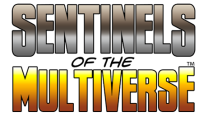Having recently received its latest expansion, Vengeance, and with a Kickstarted tactical hex-grid combat continuation of the series on the way, now seems like a good time to take a look at Sentinels of the Multiverse as it stands. This will function as both a brief overview of the game and its expansions as well as a review.
When looking for superhero-themed tabletop games, the current mainstream offerings are generally deck-building ones in the vein of Dominion or closer to CCGs like the recently released Marvel Dice Masters . The most glaring issue is that you never truly get to feel like a unique superhero yourself, merely a person putting together an ‘engine’ of cards that should power you to victory. Sentinels of the Multiverse offers an alternative. It is a superhero-themed cooperative card game for 2-5 players, but it puts those players in charge of a single hero, each with their own backstory and vastly different playstyles within that team.
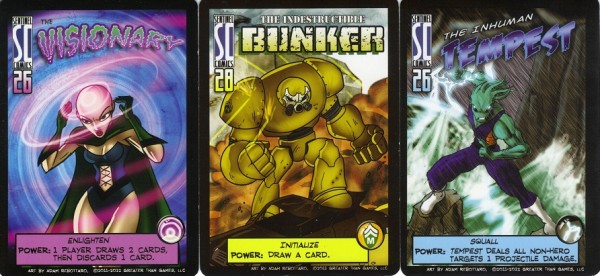
Setup is simple. You choose a villain to face, an environment in which to do battle and your team of heroes. There is a balancing mechanic for the number of heroes — introduced in the first expansion and since retrofitted to the original release in the ‘Enhanced Edition’ — which factors into certain cards that utilise an H symbol (H = number of heroes, to minimum value of 3), so that even a team of five still shouldn’t find any particular villain a total pushover. Games tend to work best with 4-5 heroes, while 3 (or even 2) can prove a nice challenge for experienced players.
Turn order is also easy to grasp. Once the villain is prepared properly, the heroes have taken their starting hand of four cards, and the environment deck is in place, everything proceeds in the same order every round: Villain phase > Hero phase > Environment phase.
The phases themselves are deceptively simple, consisting merely of basic instructions — Villain plays a card; in turn Heroes may play a card, use a power and then draw a card (or skip the play and power portions to draw two cards instead); Environment plays a card — but it’s the numerous effects that come into play that will drastically alter the ‘battle’ in various ways.
For starters, since no one controls the villain, each has its own setup and gameplay rules dictated by their character cards that combine with the general play rules to function as its ‘AI’. Depending on the theme and mechanics of the villain, they might start with dastardly devices or minions in play equivalent to the number of heroes, others might have a trusty ship or some sort of super-weapon. In other cases, they will have special rules like trigger effects or immunities.
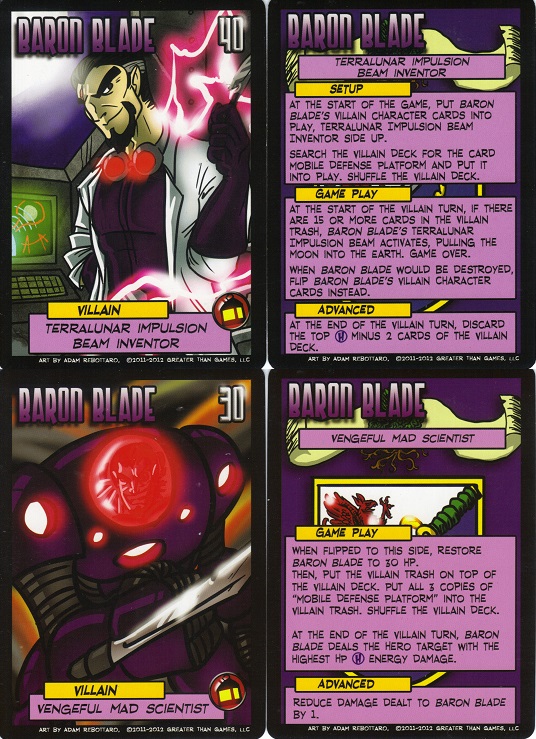
Each villain also has a ‘flip’ condition, by which their character and gameplay card is flipped to reveal new instructions that will suddenly and dramatically alter how they play, therefore requiring a shift in tactics by the heroes. This can be a constantly occurring thing or something that creates a ‘game of two halves’. For example, one villain, if ever bereft of minions, flips (literally and figuratively) and becomes a raging berserker who starts dealing increased damage directly to the heroes where before he was letting his underlings do the offensive work. Additionally, though, allow this villain to field too many minions and it triggers an automatic-lose condition. In this scenario, the heroes have to carefully balance their minion-destruction as well as mitigate or balance the damage being dealt back to them. It’s this need for prioritising threats, assisting teammates and, occasionally, self-sacrifice, that really emphasises the cooperative aspect.
And that’s before I’ve even mentioned the actual hero, villain and environment decks themselves. Among the various cards that come into play will be other effects. Some might have immediate ramifications (one-shots) or they might have long-term passive effects or those that trigger at the start or end of a particular phase or turn (ongoing, equipment or minions).
Once multiple minions, gadgets, weapons and environmental effects are in play, each with their own start/end of turn or triggered conditions and various interactions, things can become quite challenging and complex fairly quickly. While the aim is (usually) to reduce the villain down to 0HP or fewer, no single match is purely about beating on the villain until they surrender.
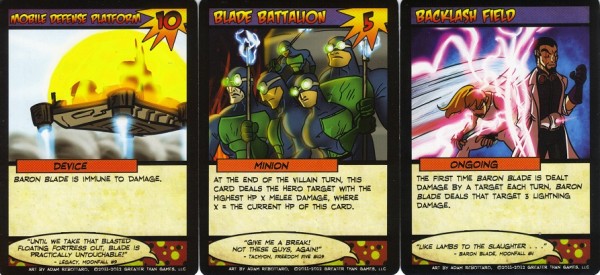
If you’re at all familiar with RPG video games with turn-based combat (older Final Fantasy games, for example), it’s a bit like a boss fight from one of those, except a great deal more demanding and varied. Each and every turn requires players to consider both the short and long-term threats and adapt to overcome (or mitigate) them.
And that’s where our heroes come in. Each has their own unique deck of forty cards, with character-specific, thematically-appropriate powers and abilities, but their usefulness will always be governed by the situation. And while a hero might specialise in a particular area (damage-dealing, buffing, tanking, deck-manipulation) the nuances of the game ensure that they’re never just a one-trick pony. For example, Legacy is great at bolstering his teammates, improving their damage or healing them, but with the right setup, he can be just as handy redirecting and absorbing damage being dished out by the villains as well as having access to some damage-dealing opportunities of his own.
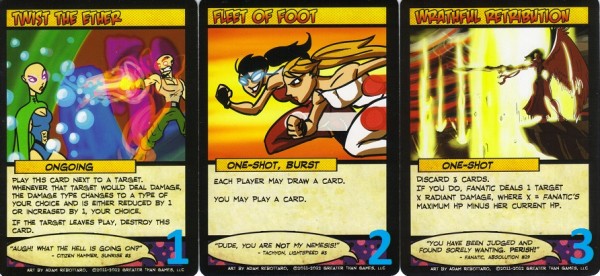
Other heroes like the psychic Visionary focus mostly on deck-manipulation, which can be crucial against certain villains or environments, but can also serve to redirect or alter damage. Bunker — a Hulkbuster Iron-Man-like suit that can field a gajillion different weapons — functions best as a huge damage-dealer via setting up a decent damage-chain, but his number of card duplicates and adaptability for drawing extra cards also makes him best-equipped to deal with any punishing effects/conditions where heroes must discard or destroy their own cards. Much like the villains, all manner of possibilities is explored and players are bound to find something to their tastes. The trick is learning the nuances of each and how best to leverage their strengths in various situations.
As a team, it’s up to you to ‘read’ the battlefield and coordinate effectively for a given moment. It can be simple things like timing attacks and card plays to get the most use out of them. It might be trying to shift your health points so that when something is stated to attack ‘the hero target with the highest HP’ you’ve got a counter-attack that will trigger, or a way to redirect or absorb that damage. In other situations, you might find the environment will take care of some threats, allowing you to focus your efforts on other matters or perhaps take a breather to forego playing a card or using a power and draw two cards instead.
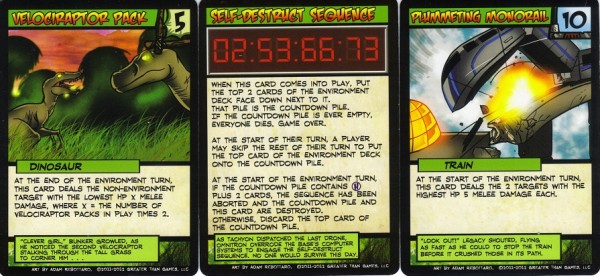
For example, I’ve had a game where packs of environment-supplied velociraptors have helped by devouring pesky minions for me, but later became a pain by finishing off ones I was trying to leave in play in order to fulfil the main villain’s flip condition and end her invulnerability. Additionally, because they go after ‘the non-environment target (i.e. hero or villain) with the lowest HP’ it might not be long before they start targeting one of the heroes next. And that’s just one example of a simple card interaction shifting over the course of a game.
In another game, some smart play, where a player ‘volunteered’ to take a hit during a tie so that they became ‘the hero target with the lowest HP’, meant things aligned so that when the main villain attacked two heroes; the first absorbed the damage, and the second counter-attacked with increased damage.
On another occasion, Absolute Zero assured everyone that the imminent volcanic eruption was ultimately a good thing, since he could convert the lava into an almighty supervillain-beating ice beam while their team would survive. Other times, it’ll be the simple delight of your martial artist hero knocking a spaceship out of the sky with a tire iron.
The way the heroes interact between themselves is also part of the fun. For example, Absolute Zero, who can do all sorts of weird and wonderful things when receiving fire or cold damage depending on what equipment he has in play, might benefit from taking a blast of fire from his teammate, Ra, because it can then be increased and directed at a villain.
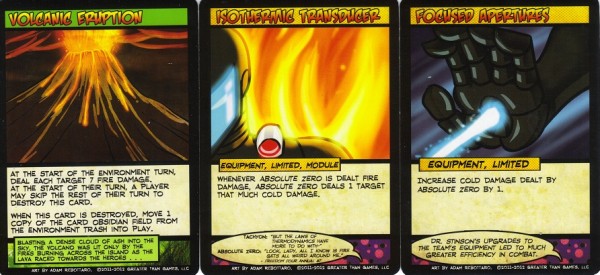
It’s these moments of daft card interactions, perfect synergy or daring, inspired play that sell the game both mechanically and thematically. You’ll discuss the short and long-term threats and form plans on-the-fly. You’ll become a dynamic superhero team, working together to overcome the odds, and if you can get invested in those small elements of storytelling, that’s where the game really shines. Of course, it does still require that willingness to engage with the narrative being created.
Fortunately, the theme should be more than enough for most people, and I find that it really elevates the entire game. In fact, many of the thematic elements tend to inform almost every part of the game’s design. When it comes to the mechanics, the card powers and abilities function in a mostly logical manner so that an invading alien warlord brings an army, a mad scientist throws out inventions and a self aware robotics factory is upgrading itself and manufacturing drones. The environments all carry their own hazards or hindrances, as well as specific creatures and characters. A city has citizens in peril and crashing monorail trains, the Savage Land-like island has dinosaurs, an ancient temple features traps, etc.
The feel of the heroes themselves is best expressed through their own decks as well. Each consists of 40 cards, but the various make-ups emphasises certain aspects and give them their own identity. The Wraith and Bunker, have various gadgets and weaponry that stay in play, with each activated as a ‘power’; Tempest has a lot of quick one-and-done weather effects that work well for attacking crowds, which can also be augmented by other equippable items; and Tachyon is a speedy, hit-and-run style character who can plink away at enemies, but also has a special attack she can work towards based on the number of cards with a certain keyword in her discard pile. Essentially, she is ‘building up speed’ by burning through her draw deck, but has to be careful not to exhaust it and force a reshuffle. That’s just one example of the care and attention that goes into designing the heroes.
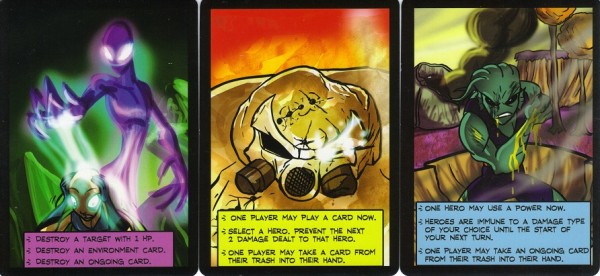
To me, I enjoy that element of becoming attached to a certain hero and their cards; learning their combinations and applications, getting a ‘feel’ for how they function. And it’s a great accomplishment given that you don’t have your actual Batman, Spider-Man, Wolverine or whoever.
Whatever it lacks in official licensing, it makes up for with its own fully fleshed-out, colourful comic book world. And trust me, it is incredibly well thought-out. While at a glance, you can identify Legacy as the Superman/Captain America-hybrid of the Multiverse world (hmm, that doesn’t sound right), The Visionary as its Jean Grey or The Wraith as its Batman, all of them have unique and elaborate backstories that have since been teased and revealed through expansions.
Part of the fun in following the game and its expansions is seeing hints of new developments on the cards themselves. Sometimes, you’ll glimpse a never-before-seen character in the artwork or simply a quote from a named but so far unseen character on the bottom. You get a sense of history and connectedness between these characters and the world, even if you are fighting a mob boss in the ruins of Atlantis.
It’s also an appreciably diverse and interesting cast. Tachyon might be The Flash, but she’s also an incredibly intelligent and playful scientist with a wife; sure, Tempest controls the weather like a certain X-Man, but he’s an alien who’s escaped a conquering alien warlord who killed or ‘integrated’ everyone on his home planet; and, yes, The Wraith is Batman… except female with very much alive and even supportive parents. There’s much to be said for the positive and diverse representations of race and gender, given that the general look and feel of the Multiverse comic book world took its initial inspiration from the relatively old-fashioned Golden Age of comic books.
In terms of the villains, those might appear rote, but all connect to the heroes (sooner or later). You have the aforementioned alien warlord, a mad scientist with a generations-spanning vendetta against the Legacy bloodline or a giant robot-creating robot (that’s a thing) governed by an AI that has turned bad (never saw that coming).
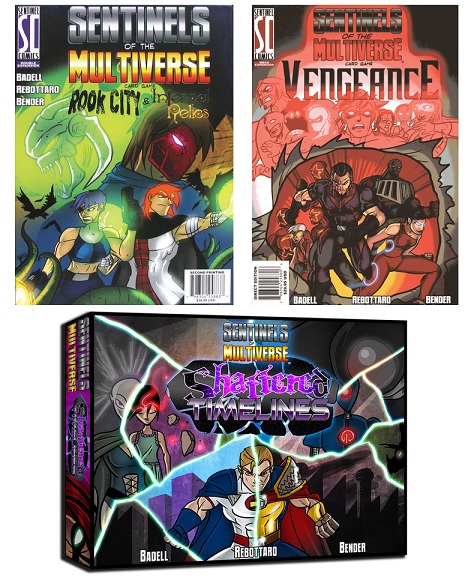
And those are just from the base game. Rook City introduces a more Gotham City-like atmosphere, not just in its two new environments but with its crime bosses, mutant rats and an experimental drug-enhanced serial killer. On the hero side you’ll see the Punisher-like Expatriette and her huge collection of guns and ammo types, and the martial artist turned car mechanic, Mr. Fixer, with his blend of tools and fighting styles.
Infernal Relics explores the mystical/horror side, with an almost purely support-role hero being introduced, and Shattered Timelines brings in alternate timeline/dimension shenanigans. You’ll see a time-travelling cowboy with a robot arm as well as alternate versions of existing characters, with villains having turned good or heroes having turned very bad, among a few other things.
Vengeance introduces a heap of interesting new heroes (including a mini-team that shares a deck), and a couple of cool new environments, as well as a variation on the usual villain setup. The included ‘Vengeance Five’ fields the same number of villains as there are heroes, with turns alternating between hero and villain. I haven’t actually haven’t had a chance to try this yet, partly because I fear the rules compatibility of some card conditions will cause headaches…
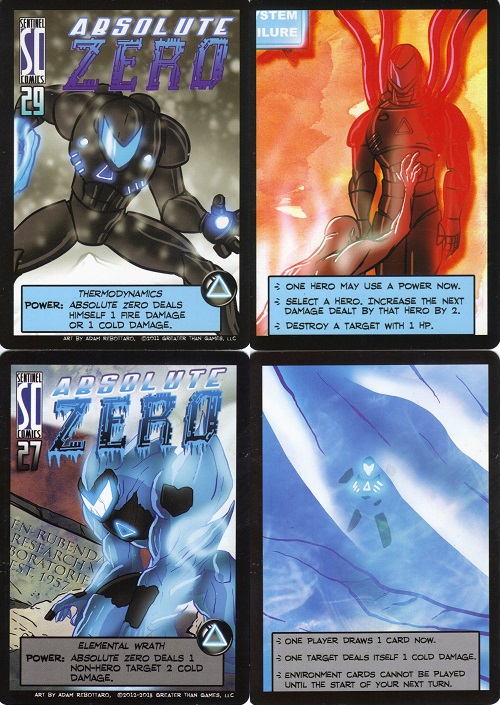
There are also mini-expansions that provide single add-ons of heroes, villains and environments as well as promotional versions of heroes and villains (you’ll have to visit eBay or spoof them off BGG) that provide interesting twists on their decks with simple mechanical tweaks. In terms of sheer replayability there are thousands of combinations to be had and the expansions further explore all the mechanical possibilities when it comes to card games.
You’ll find heroes with more complex elements of hand management, others in entirely support roles; you’ll see duos/groups of villains; a traitorous villain who is not ‘revealed’ and, therefore, cannot be targeted until other threats/diversions are survived/resolved; a Dark Phoenix-esque version of one hero who must be kept alive, but their nightmarish projections slain; and another villain who can infect heroes, turning them against one another.
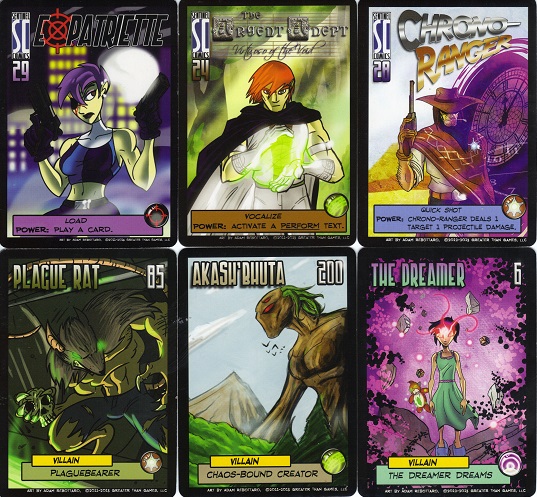
All sounds well and good, but there are a few potential issues with the game. The severity of them will really depend on your own tastes and gaming group, but I feel they are worth mentioning if simply because my own regular gaming group actually no longer wishes to play.
I’m aware that a few of the negative aspects of my and my group’s time with the game are partly down to my own inexperience when introducing/running the game and simple incompatibility, but perhaps that demonstrates a slight lack of appeal and accessibility across a certain number of players.
Firstly, my group are big on randomness even when rules dictate a certain order to game setup. If it’s Smash Up, we’re blindly picking factions. If it’s Firefly, we’ll randomly deal leaders and ships. When it comes to Sentinels of the Multiverse, this is a very bad idea.
Since we all learned the game together, we had no clear picture of how each hero played, which is a major problem with a game so challenging and reliant on coordinated teamwork. And there were unwelcome surprises when one person discovered that the Superman-like Legacy was more of a support character, spending most of his time boosting damage for other players, while another was annoyed that Visionary never had much opportunity to directly attack the villain. Those heroes’ abilities were both incredibly beneficial in many other ways but were simply not to their taste. I’ve come across a few heroes I did not enjoy because I just couldn’t gel with their particular style of play.
Without a doubt, it’s a game that really needs multiple playthroughs with the same hero or at least some time to learn the decks and get a feel for what you need to be doing. As you might guess with a group so fond of randomness, they’re not so keen on the deeper elements or doing plenty of replays with any frequency, especially not if it takes more than half an hour at a time.
Fair enough, that’s my fault, lesson learned. Although, even if players get a sense for what they like (the player who didn’t like The Visionary, did great with Absolute Zero) that doesn’t always mean the game will run smoothly. Because of the diversity of villain game mechanics and extra spanners thrown in the works by the environment, you’re never guaranteed that the whole group will have a good time.
Even though the heroes are somewhat versatile, certain ones don’t function so well in particular situations, and players might find themselves ‘locked out’ of the game either because they never get the chance to set up a decent combination of cards or have to follow everyone else’s lead in order to achieve victory. That might be an odd criticism of a cooperative game — personally I’m more than willing to help however the team needs it — but I can appreciate how that aspect won’t be to everyone’s liking. Much like with Legacy and The Visionary, some players might never feel significant unless actively destroying minions and effects, even if they are contributing in other ways by absorbing, mitigating or neutralising other harmful factors or helping the team to plan ahead.
And part of the problem is that those types of supporting roles can be essential against tougher villains, in the same way you would want an RPG party to have a make-up of similar roles like tank, damage-dealer and healer/support.
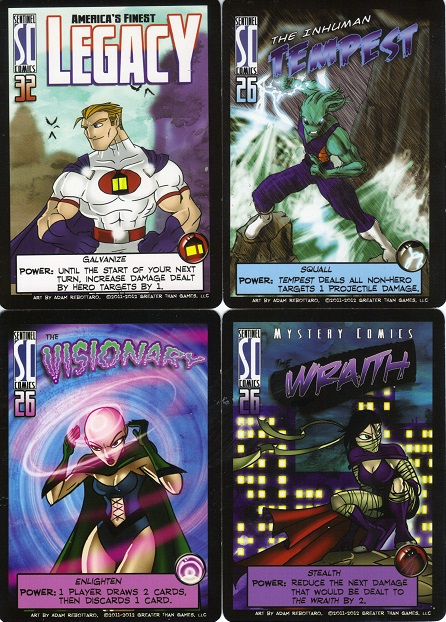
The other main issue, and one that is likely universal, is how ‘messy’ games tend to become.
Before the heroes even get their first turn, you could have a villain and five minions, each with their own HP, start/end of turn effects. Soon after that, you’ll have the environment deck adding modifiers that can affect all sides as well as its own creatures and characters with their own HP and specific effects. Gradually, you might find yourself transforming from superhero into accountant, and feeling just as heroic.
Now, I know I praised how deep and tactical the game can become, but what I can appreciate about clever game design is when they’ve found that sweet spot between complex and convoluted. I wouldn’t dare question the meticulous design and playtesting that has gone into creating balanced, challenging gameplay, but that doesn’t necessarily mean it’s always fun. And there’s no easy fix because it really can vary depending on the match-up of villain, heroes and environment or simply the turn order and what cards come out.
It’s true that the rulebooks give you a ‘difficulty’ rating for the villains and a ‘complexity’ rating for the heroes, but that doesn’t provide an upfront overview or accurate idea of how a game might play. I’ve had seemingly difficult villains fall prey to a fortunate hero showing where a winning combo was easy to maintain, while those same villains have proven insurmountable with a slightly different team. It’s great to see how the outcomes can wind up so varied, but whether it’s an easy game or a challenging one, they won’t appeal to everyone.
And even if you can wrap your head around everything at once, the actual implementation can really bog the game down, robbing it of any momentum. At times, you’ll find yourself wanting to do one simple thing like playing a card to deal damage, but you have to keep in mind that doing so will trigger an effect on another card, when both the villain and environment are modifying damage already, but that if you don’t stop another thing it’ll force you to destroy or discard one of your cards before your next turn.
Other times, you might simply miss one crucial factor, so your teammate will have to point out the problem. Sure, that’s part of being a team, but it’s certainly no fun hearing, “If you play that, your damage is being reduced so much that it won’t actually get through and you’ll trigger this which will damage everyone.” Then you look at your hand of cards, from which you’ve already been forced to discard a couple, and see that your only real option is to do nothing except draw new cards and hope you get the opportunity to do something next round… once the villain and environment have fielded more problems, hit you for a bit more damage and potentially robbed you of a few more cards.
Then you’ve got the regular occasions of upkeep every turn where you have to run through the villain’s or environment’s various minions and effects in order, checking when they trigger and constantly reappraising health values for where a card’s effect mentions it.
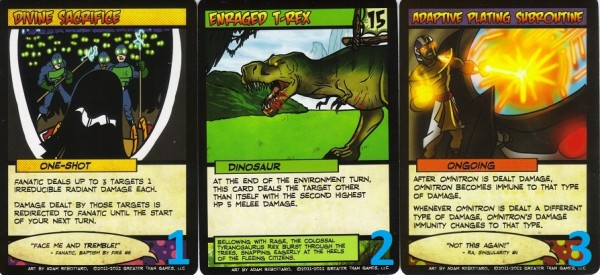
And it’s very easy to overlook things or fudge rules because there is so much to keep track of and important distinctions to be followed for the sake of balance. You’ll need to keep an eye on the keywords on most of the cards, you’ll need to note the difference between destroy and discard, the implications of revealing cards from a deck versus searching a deck, and the confusion of ‘putting a card into play’ compared to ‘playing a card’. Then you’ll have instances where you’ll be trying to track where damage is actually coming from and whom it affects as well as the order that things came into play in case of priorities. Other times it’ll be confusion over wordings like ‘a target’ or ‘another target’ (where the former would allow multiple hits to the same target). It’s a shame that there is no easy way to present a lot of the game’s elements, as each and every card will have at least one paragraph of text explaining its effects. Even the elemental aspect of attacks — which don’t really matter… until they matter — are written out rather than with easily-recognisable icons. You are pretty much guaranteed to miss at least one major rule during your first game.
Fortunately, the community surrounding the game is brilliant. You can visit the official Greater Than Games forum where you’ll find an entire subforum on Rules and a multitude of friendly faces willing to address/argue over your queries so that you’ll find a definitive/official answer or at least a logical consensus. You’ll find helpful apps that take care of HP-tracking and sorting or even ‘randomizers‘ built off of a ginormous statistical project of fan-submitted/recorded games, which you can use simply to assess the chances of victory with a particular set-up rather than for random selection. Again, randomise at your own peril.
Really the main thing to be aware of is that, while it might have all the appearance of a light, breezy game with some dynamic heroics, more often than not it can feel like ‘bookkeeping’ or an epic slog (much like reading this review perhaps). There’s still heaps of fun to be had even with rule mishaps and certain match-ups, but it’s definitely something to be aware of. My particular group found it a little disappointing if we missed something that worked out to our advantage or if we caught a mistake and had to backtrack a few busy turns to reset things to how they were. Frankly, I can understand the gripe, because when the game has been playtested so thoroughly for balance, just one little error could be pivotal, and it’s no fun to discover you effectively ‘cheated’ or inadvertently turned the game into a cakewalk.
All of my more recent sessions have been solo experiences, and I’m okay with that. It still plays well — much like the turn-based JRPG comparison I made earlier — and, in fact, it eliminates the other minor issue that can occur in team games: playing other people’s turns for them. Perhaps this isn’t such an issue when playing properly as a team, and with players who have learned their own particular hero’s play style rather than randomly selecting them, but one it’s one I noticed among my group at times.
It’s actually quite fun to purposely assemble your own team to face a villain in a particular environment; maybe something thematically appropriate or just something very bizarre. Part of the enjoyment is seeing the unexpected possibilities that emerge when you put together your team.
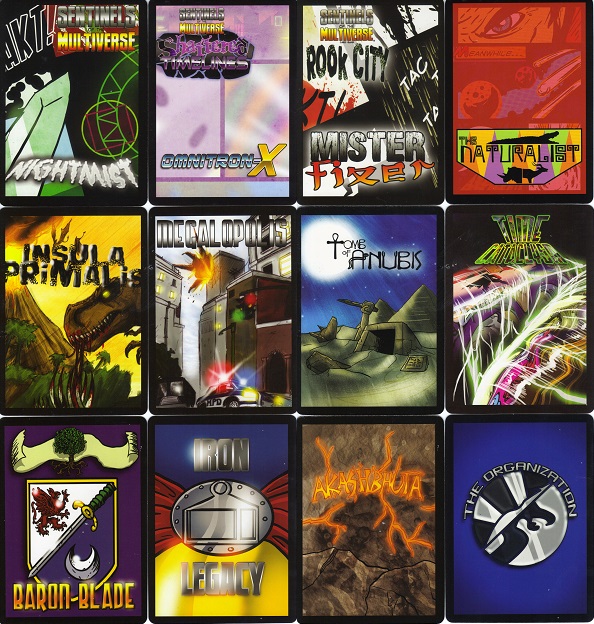
Whether it’s fun or not for you and your group really comes down to what you bring to the experience. It’s not an RPG, but it benefits from feeling that sense of playing a role within your team and using your imagination to construct the story behind the various situations and card interactions. Those moments where you snatch victory from the jaws of defeat by catching a falling monorail train with a grappling hook, or silly things like saving a citizen by smacking them into the stratosphere, is part of why I play games. With that investment, you can spend a good while locked in an epic struggle alongside your friends, discussing each obstacle as a team and pulling off wonderful coordinated card plays.
It’s just a pity that a great deal of that can be obscured by the constant maintenance that the game requires. It’s not overly complex, and probably child’s play to seasoned card gamers, but even if rule mistakes don’t concern you so much, you still need to be prepared for a lot of reading through cards each and every turn just to keep the game moving.
Ultimately, it’s a distinctive superhero card game that really emphasises and builds on its theme, but requires some dedication to get the most from it. If you’ve got a patient group of people with a fondness for superheroes and cooperative play then Sentinels of the Multiverse could the perfect game for you.
